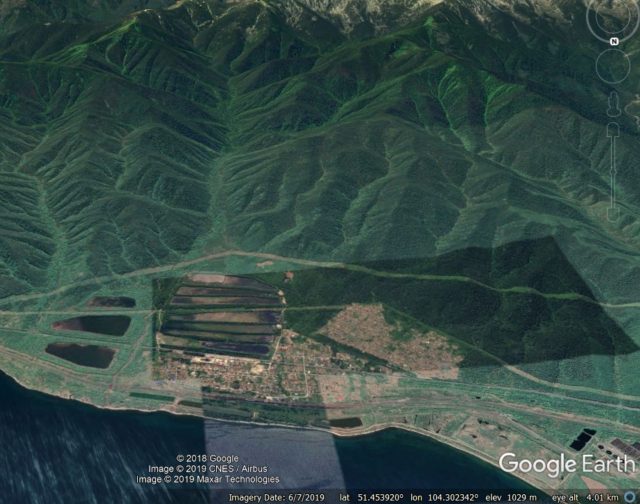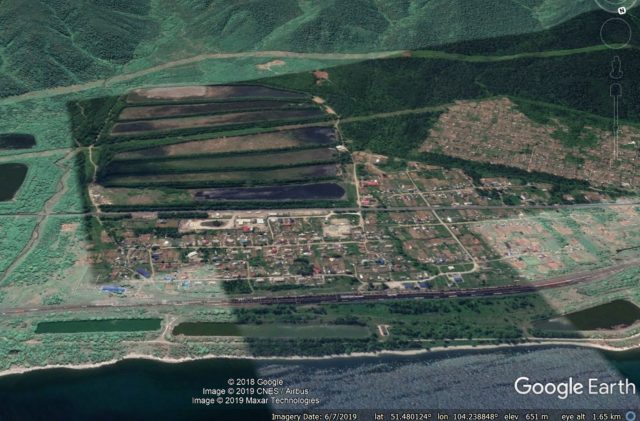Dr.Dave Petley from the University of Sheffield in the United Kingdom monitors landslide events occurring worldwide. This winter he helped to assess the landslide which blocked the Bureya River. Today he is horrified by risks posed by the Baikal Pulp and Paper Mill sludge ponds. Several days of heavy rain flooded the town of Baikalsk and exacerbated long-expected threats of mudslide that may push toxic sludge from defunct ponds into the Lake. Reports from the field are so confusing, that they show only the sad fact that no one is really in charge of facing this challenge. The RwB sought opinion of international experts on the degree of risk. Dave’s text follows.
In the wake of my recent posts on the high risks associated with tailings facilities, my friends at the Rivers without Boundaries coalition have contacted me to draw my attention to a really interesting, and deeply alarming, situation at Baikalsk in Russia, which sits on the banks of Lake Baikal. As you may be aware, Lake Baikal is the largest freshwater lake on Earth, containing about 22% of the World’s surface freshwater. As such, it is an immensely important resource.
The issue at hand is a set of waste storage ponds built on the banks of the lake on the edge of the town of Baikalsk. These waste storage facilities were built to deal with waste from the Baikalsk pulp and paper mill, which was shut down in 2013.

The image shows at least 13 waste storage ponds in three clusters. Three are located very close to the bank of the lake, three larger facilities are located to the east and the remainder are situated upslope of the works in a staircase up the hillside. These can be seen more clearly below:-

The potential threat here lies in the setting of the waste ponds. As the first image shows, the whole site is located on an active fan fed by the channel that emerges from the mountains. It is entirely reasonable, based upon the morphology, to assume that this channel is subject to flash floods and debris flows. In these systems, one would expect that high volume flows will overflow the channel and migrate across the fan. If so, the first waste pond in the staircase would be at high risk of being inundated. This threat is substantial – indeed there is a paper online (Stupin et al. 2018 – NB PDF) that has examined the behaviour of these systems, and noted that:
A special emphasis shall be placed on mudflow hazards caused by small river basins of the Bolshaya and Malaya Osinovka flowing into the Lake Baikal to the east of the Baykalsk city and the resulting destruction of settling basins and disposal of poisonous wastes to the Lake Baikal in case of extraordinary rise of water level (5 m and more)… This nearly happened during the flood in 1971 when emergency measures were only able to prevent the irruption of high waters into settling basins.
The potential consequences of such an event entering the highest waste storage pond should be clear – indeed, based on the image above the likelihood of a very large debris flow breaching the first waste pond looks to be very high indeed. This pond would probably fail, inundating the next one downslope, and so on. Thus, it is entirely feasible that seven or more storage facilities could fail, releasing the waste into the lake. Of course, the three ponds to the east are also vulnerable.
The 13 waste storage ponds are reported to store about 6.2 million tons of waste in total.
It is difficult to ascertain the true level of threat at this site, but it must be considered to be very high. The worst case scenario is the one that I have outlined above, but of course pollution could also be released by the failure of the retaining structures at any of the 13 ponds.
At the very least, it seems to me that this site needs an urgent assessment of the integrity of each of the retaining structures (if this has not already been undertaken), and works to manage the flows in the channel to minimise the potential for the ponds being breached. Stupin et al. (2018) note that:
Throughout the entire historical period the considered territory is characterized by numerous clearance of debris flows with high frequency, but unclear periodicity. The last disastrous mudflow took place in 1971 and 1973 and since then the given territory was quite standard, which is unfavorable since the longer the interval between mudflows, the stronger and more dangerous they are.
The risks at this waste storage site are clearly unacceptably high, and the consequences of a major failure into Lake Baikal at Baikalsk would be truly catastrophic. And it is worth noting that these are not the only waste storage ponds in this area.
Sources: https://blogs.agu.org/landslideblog/2019/07/30/baikalsk-1/
Stupin, V.P. et al 2018. System of geo-information mapping of debris flows hazard in the southern Baikal region. IOP Conference Series: Earth and Environmental Science 194 102002.

